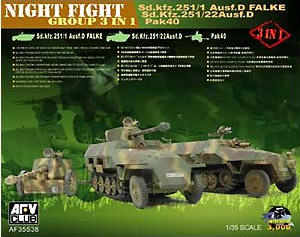The Night Fight Group kit has two complete Sd.Kfz.251 Ausf.D kits plus the PaK40 Anti-Tank gun to give you the Sd.Kfz.251/1 Ausf.D “Falke” (Falcon), the Sd.Kfz.251/22 Ausf.D “Pakwagen" and 7.5cm PaK40 all with IR equipment but of these only the “Falke” has a documented history. There is no record as far as I am aware of the Sd.Kfz.251/22 IR proceeding past the planning stage and there are only a couple of obscure references to the PaK40 IR in some personal service accounts from late in the war.
But that aside given the advanced testing of the “UHU”, “Falke” and Panther G IR as well as experimental MP44 with IR sights the Sd.Kfz.251/22 and PaK40 with IR gear was certainly a reasonable probability had the war continued later into 1945/46.
The standard of moulding is again excellent overall with virtually no pin marks to be seen which is especially noticeable on the hull sides, the real hull panel and doors which have details on both sides but not one pin mark to be seen. There are a number of small plastic ‘nodes’ on some parts to be carefully removed but these help to reduce pin marks and a few minor sink marks most notable on the front lower hull extensions plus the odd bit of minor flash but nothing to get excited about and are easy to deal with as are the normal mould seam lines on the parts.
The details included on the parts is also very good with nice bolt head details on the hull and fenders as well as nicely rendered weld seams on the forward hull/engine compartment and the excellent tread plate pattern on the interior floor panels. There are quite a few very small parts such as the small plastic shield bolts on the PaK40 that will need care removing from the sprues and during assembly but shouldn’t pose problems for those will some basic modelling experience.
The gun shields are provided in two pre-bent pressed brass parts with
very small plastic studs to add for the spacers that will require care
as they can get a bit fiddley?
Additional etched parts are provided for the central bolted plates and
the small front sliding shield and top sill and added to the top of the
shields is the 20cm searchlight in two parts with clear front lens and
a small mounting bracket as a separate part.
The ‘rubber’ tyres are well done and have the two longitudinal groves and the "Continental" embossing on the sidewall plus a sizable sink hole at the pour point in the middle of the tread but this can be positioned on the ground contact so isn’t really a problem at all. These are fitted to the nice wheels with nicely represented wheel spokes which have separate brake drums, hand brake lever and other small fittings.
The trailing arms can be positioned in either the closed transport mode or split firing position with alternate positioned parts depending on your choice.
The metal barrel has a two part plastic muzzle brake and five part breech with separate sliding block are positioned over small notches at either end of the barrel for a secure fit and you should obviously make sure the muzzle brake and breech are lined up correctly before final gluing.
Construction is fairly conventional for this type of gun with the gun/cradle, trunnion assembly, base with split trailing arms and wheels able to be built as sub-assemblies and married together to finish of the model. The brass shields have very fine mounting arms and care should be taken when fitting these as well as with the many other fine parts on the gun mounting and trailing arms.
This builds into an excellent replica of the PaK40 as it comes with the metal barrel and etched shields adding to the final appearance.
The hull sides have the internal panelling used to fix the internal fittings with the gap between the hull side and panels represented by small indentations along the top of the hull sides while the rear hull floor section is a further separate part again with separate rear doors. The underside hull panel is another separate part to allow the inclusion of all the bolt and panel line details.
The suspension is
the same as with previous kits with the road wheels having excellent
details including the spot welds around the rims and on the drive sprocket
the correct offset of the drive teeth as well as the drive rollers
included while the front tyres have excellent tread pattern and good
hub details on the wheels.
The lower hull sides have excellent details on the axle mountings as
well as the raised reinforcing panels along the lower hull sides around
the axles and bump stops with all the axles as separate parts which
will allow you to animate the suspension if you wish?
This is a strange inclusion as these all steel tracks were only used for about five months from late February to July '44 when they was discontinued as the metal pads created excessive vibrations on paved roads damaging the suspension components.
The use of the Sd.Kfz.251 Track “Late Model” (Kit #AF35069) or even the more common Sd.Kfz.251 Track “Early Type” (Kit #AF35044) would have been more appropriate as both these tracks were used throughout the War eliminating any time line issues.
Considering the first Sd.Kfz.251/22 was only produced in December 1944 and the “Falke” and other IR programs didn’t get underway seriously until Feb/March 1945 the tracks provided were withdrawn from use well before then.
As mentioned there is the new late upper hull included for the 251/22 version and this has the engine bay access door modified for the later rear opening door with the small side opening panel added at the front with nicely defined hinges on the right side. The flush screws are included around the opening and the separate one piece hatch has nice hinge detail as well as small bolts and latch detail on the inside which is also completely free of any pin marks.
The two front fenders are separate parts and also have very nice bolt head and panel details with a two part Bosch headlight and base for the left fender as well as three parts for the exhaust system and the pioneer tools carried on the fenders come with moulded on tool clips.
On the front plate of the 251/22 is a small bracket that includes an aerial base but this bracket was actually for another 20cm IR searchlight of the type carried in front of the driver’s plate and as there is three sprue N for the “Falke” included this has a couple a spare 20cm searchlights so you can easily add one to the mounting as well as adding the wiring for additional detail. The instructions indicate to add the 20cm searchlight on this bracket for the “Falke” version as it should be and again adding the wiring will finish off the light nicely.
Also included on both is the small V shaped guard added to the left side of the engine deck just in front of the driver’s plate which is actually the exit point for the IR FG 1252 Scope wiring but this is moulded solid and you may want to replace with thin card to form the hollow V shape?
In the middle of the engine deck between the two visors is the 20cm IR searchlight with separate bolted attachment plate with the searchlight having a separate clear plastic “lens” added which can be painted black or dark blue on the inside before fitting while positioned in front of the driver’s visor is the Driver’s IR FG 1252 scope made up of one plastic and two clear parts.
The side storage boxes have two doors on each side opened up with separate doors and finely moulded hinge detail although the doors them selves are a little thick if shown open. The doors included moulded on padlock and latch detail while at the rear are separate tail light and other fittings.
The driver's seats have two part lower sections and the back rests with superb cushion detail on one side and the distinctive spring pattern on the back and as mentioned no pin marks to spoil the detail.
The forward Driver’s panel on the “Falke” has separate outer vision port covers with each internal visor having three parts each for excellent detail definition and the two side vision slits also have two part internal armoured glass housings. The vision ports are in the solid plastic and not the clear vision port parts in some previous kits but can be shown open or closed as desired? The Driver’s panel on the 251/22 has the right visor blanked off and the flush visor for the Driver as is the case with the /22.
The forward top hull section is a separate part with separate correctly squared off bullet splash guard for the “Falke” while the 251/22 has the cut-down panel to make room for the PaK40.
Moving back in the “Falke” there are the two hull side bolted flanges as separate parts again for good detail definition and there are the rifle racks with very nice Kar98s and the crew seats and back rests are very well done with a choice of early leather cushions or later wooden slat bench details while there is also the separate grab handle railing along the inside of the upper hull sides.
One issue due to the initial “Falke” vehicles being converted from the 251/20 "UHU" is there should actually still be the raised rear section that was lifted by 50mm to include additional bracing for the large searchlight turntable base but just the standard floor is included.
The Fu 5 radio rack is mounted between the Driver and Co-Driver and this is provided correctly (part 14) as are additional radio equipment boxes on the hull sides (parts N13, N5) and these could have fine wiring added for final detailing.
The “Falke” armament consists of a nicely detailed MG42 on the s.M.G Lafette (mounting) and this is very finely moulded and includes the FG 1250 IR scope added to the MG42 for sighting which is made up of four plastic and two clear parts and is quite nice but again you can add the wiring to finish off.
The rear doors are both separate with the hinge and latch detail moulded on and can be positioned in the open or closed position as you wish?
On the 251/22 the side hull flanges have been replaced with new items that incorporate the mounting bulkheads for the PaK40 mounting girders and large right side ammo bin, there is also a smaller ammo bin that is positioned just inboard of the right PaK40 support arm.
The main PaK40 support frame is made of two side girders and one rear cross member with the lower gun mounting plate trapped between the two and these locate into the floor locating holes and to the top of the side bulkheads although there is no forward bulkhead cross member. There is also the small crew seat attached to the left support girder plus the two rear crew sets from the previous kits.
Added to the top of the shields is again the 20cm searchlight in two parts with clear front lens and a small mounting bracket as a separate part.
The gun includes the metal barrel with a two part plastic muzzle brake
and five part breech with separate sliding block positioned over small
notches at either end of the barrel for a secure fit and you should obviously
make sure the muzzle brake and breech are lined up correctly before final
gluing.
Also included is the second crew guard on the right of the gun which was
missing from the original 251/22 which is nice to see these corrections
being made without fuss.
The gun travel lock is correctly mounted on the front of the driver's plate while the lock itself is fairly basic in details and there is the new right hull side mounted antenna base.
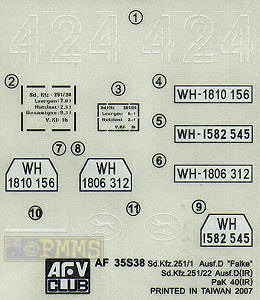














Detail Images

Close new window to return to review
| Nuts & Bolts
Vol.18 Marder III H & 7.5cm Pak40  |
Sdkfz251 Ausf.C & D Panzer Tracts N0.15-3 ISBN 0-9771643-5-7  |
Sd.Kfz.251/1
in detail Special Museum Line No.37 Wings & Wheels Publications ISBN 80-86416-50-X 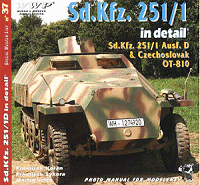 |
| Sd Kfz 251 Tank Power Vol.X Wydawnictwo Militaria No.224 ISBN: 83-7219-224-3 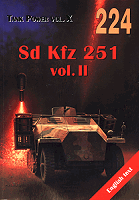 |
Schutzenpanzer (Armored Personnel Carrier) Ryton Publications ISBN: 1930571291 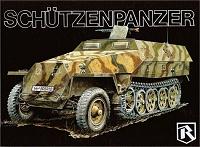 |
Sd.Kfz.251/1
Ausf.D Model Detail Photo Monograph No.22 RossaGraph ISBN : 83-89717-60-3 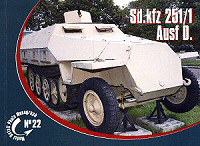 |
![]() Thanks
to AFV
Club for the review kit.
Thanks
to AFV
Club for the review kit.
![]() is
distributed in Australia by J.B.Wholesalers
is
distributed in Australia by J.B.Wholesalers


